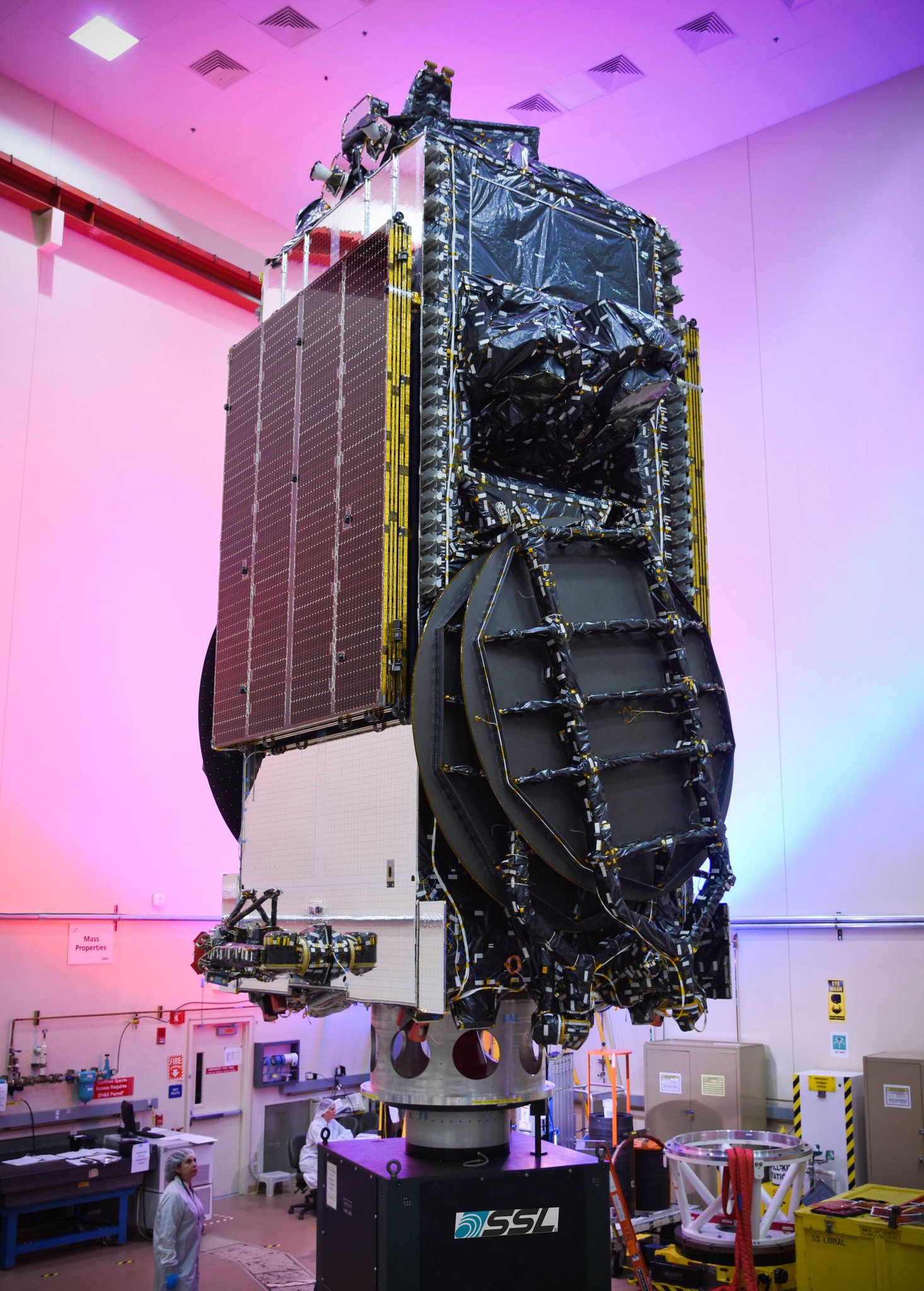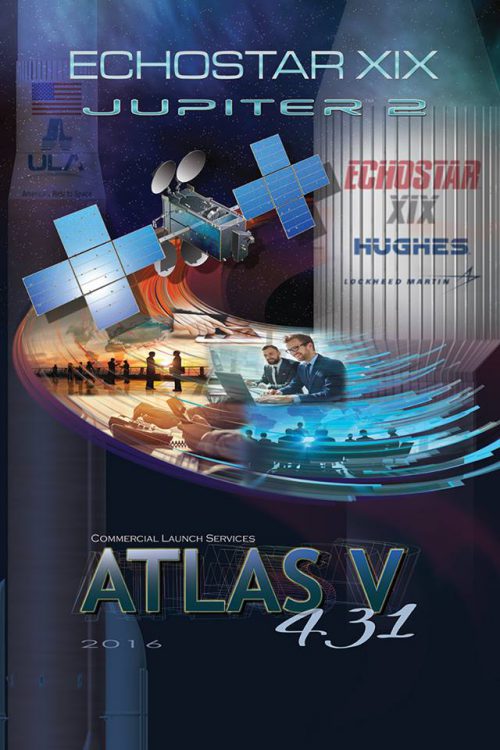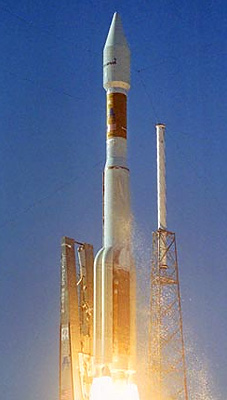
Over the last decade, United Launch Alliance (ULA) has earned a strong reputation for reliability and schedule adherence, with 114 Delta II, Atlas V, and Delta IV missions successfully completed between 14 December 2006 and last week’s flight of the latest Wideband Global Satcom (WGS-8). Although the bulk of customers for the Centennial, Colo.-based launch services company have been the National Reconnaissance Office (NRO) and the Air Force, numerous other missions devoted to studies of our own world and other worlds have also been conducted. However, this weekend, ULA will launch an uncommon mission on two fronts: for it will fly a rarely-used version of its highly reliable Atlas V booster and will deliver—for only the fourth time in its history—a commercial communications satellite into Geostationary Transfer Orbit (GTO). And not just any satellite: for EchoStar-XIX will represent the largest and most capable high-speed broadband internet ever placed into orbit.
Formed in 1980, originally as a distributor for C-band television systems, EchoStar received a Direct Broadcast Satellite (DBS) license at 119 degrees West longitude in 1992. Three years later, in December 1995, its first satellite—EchoStar-I—was launched atop a Chinese Long March 2E booster and shortly afterwards the company began marketing its home satellite TV system, branded “Dish Network.” Although the next two EchoStar satellites, launched in 1996 and 1997, suffered from significant failures, subsequent missions lofted atop Proton, Atlas, Zenit, and Ariane rockets went on to provide communications services across the contiguous United States, as well as Alaska and Hawaii, together with Bermuda, Mexico, Puerto Rico, and other locations. By the time EchoStar-XVIII launched atop an Ariane 5 booster in June 2016, Dish Network had accrued almost 14 million subscribers for its pay-TV services. Further EchoStar missions are slated to fly later in December aboard an International Launch Services (ILS) Proton-M and in 2017 aboard SpaceX’s Upgraded Falcon 9.

EchoStar-XIX has been built by Space Systems/Loral (SS/L), based upon its highly reliable SSL-1300 “bus,” which last year recorded 100 of these satellites launched into Earth orbit. There are, of course, major differences between those 100 satellites, which have been launched over almost three decades. Compared to the first-flown member of the fleet, Japan’s Superbird-A, launched in June 1989, today’s SSL-1300 bus produces eight times more power, a 30-percent longer operational life span, and can house four times as many transponders. SS/L was selected by Hughes Network Systems—a wholly owned subsidiary of EchoStar Corp.—to build EchoStar-XIX in March 2013. Alternatively dubbed “Jupiter-2,” the satellite is expected to meet “the growing demand for HughesNet Gen4 high-speed internet service in North America” and would carry 50 percent more capacity than its predecessor, EchoStar-XVII, which is also known as Jupiter-1.
Weighing approximately 13,900 pounds (6,300 kg), EchoStar-XIX is a large, multi-spot-beam Ka-band satellite and carries a pair of X-shaped solar array “paddles” for between 5-12 kilowatts of continuous electrical power provision. It can support an operational lifetime at geostationary altitude of 15 years and carries a total of 138 user beams and 22 “gateway” beams, generated via four antennas. In August 2015, Lockheed Martin Commercial Launch Services (LMCLS) was selected to provide EchoStar-XIX launch services, via ULA’s Atlas V booster. It was noted by Space News that EchoStar originally intended to use an Ariane 5, but that the manifest for the European booster was full in late 2016. A significant expansion in EchoStar’s consumer broadband subscriber base was reportedly a key driver as the company aimed for a late 2016 launch.
Last month, EchoStar-XIX was flown cross-country aboard an Antonov heavy airlifter from SS/L’s facility in Palo Alto, Calif., touching down in darkness at the Kennedy Space Center (KSC) in Florida. It was uncrated and proceeded through fueling and final checkouts, ahead of integration with the Atlas V launch vehicle. Interestingly, just a few days later, the EchoStar-XXI satellite arrived at Baikonur Cosmodrome in Kazakhstan, ready for its own Proton-M launch in December 2016.
In launching EchoStar-XIX, ULA will be delivering only its fourth commercial communications satellite passenger to orbit. The 14,625-pound (6,635-kg) ICO-G1 spacecraft was the largest and most massive commercial communications satellite in the world at the time of its April 2008 launch and was followed by Intelsat-14 in November 2009 and more recently Morelos-3 in October 2015.
Sunday’s flight will also mark only the third outing of the Atlas V 431, which is equipped with a 14-foot-diameter (4-meter) Extra-Extended Payload Fairing (XEPF), three strap-on, solid-fueled boosters, and a single-engine Centaur upper stage. This configuration has the potential to transport up to 33,660 pounds (15,260 kg) to low-Earth orbit and up to 16,970 pounds (7,700 kg) to GTO and was previously used to launch Intelsat-14 in the fall of 2009 and the Inmarsat 4-F1 commercial communications satellite—under the auspices of ILS—way back in March 2005.
The EchoStar-XIX mission wraps up a highly successful 2016 for ULA, which will total 12 launches in as many months. Including Sunday’s flight, eight Atlas Vs and four Delta IVs will have launched from Vandenberg Air Force Base, Calif., and the Cape, placing seven military reconnaissance, surveillance, communications, and navigation payloads into orbit, together with the WorldView-4 commercial Earth-imaging satellite, the latest Geostationary Operational Environmental Satellite (GOES-R), and a single Cygnus cargo mission, bound for the International Space Station (ISS). Additionally, the Origins, Spectral Interpretation, Resource Identification, Security, Regolith Explorer (OSIRIS-REx) sample return mission was launched in September, headed for the carbonaceous asteroid Bennu.
Following last month’s nighttime liftoff of GOES-R from SLC-41 at the Cape, efforts entered high gear to configure the facility for its EchoStar-XIX role. Originally targeted for a 16 December launch—just nine days after WGS-8 rocketed into orbit from the Cape’s SLC-37B—it was announced by ULA last weekend that a 48-hour postponement would be effected. “During the flight control system final checkout, a component exhibited off-nominal behavior,” ULA reported on its website. “The first-stage booster component will be replaced and retested early next week. This additional time will allow the ULA team to ensure all systems are operating nominally prior to final launch preparations.”
Sunday’s launch is timed to occur during a two-hour “window,” which extends from 1:27 p.m. through 3:27 p.m. EST. Assembly of the Atlas V 431 vehicle is complete, with the 106.5-foot-long (32.5-meter) Common Core Booster (CCB) having been mated to the 41.5-foot-long (12.6-meter) Centaur upper stage in the Vertical Integration Facility (VIF) at SLC-41. The three Aerojet Rocketdyne-furnished AJ-60A solid-fueled boosters—each of which measures 55.7 feet (17 meters) in length—were mated to the lower part of the CCB, completing the 431 stack. Elsewhere, EchoStar-XIX was encapsulated within its 45.3-foot-long (13.8-meter) XEPF earlier this week, and the payload was transported to SLC-41 and installed atop the Atlas V. When complete, the vehicle stood an impressive 194 feet (59 meters) tall.

The approximately quarter-mile (400-meter) rollout from the VIF to the SLC-41 pad surface will occur on Saturday and should require about 35 minutes to complete. When the Atlas V is “hard-down” on the pad, it will be centered and propellant umbilicals and electrical and data connections will be established. The track mobiles from the Mobile Launch Platform (MLP) will be removed. Early Sunday, flight control systems will be initiated, ground command, control, and communications instrumentation will be brought online and interfaces between the vehicle and the Launch Control Center (LCC) will be verified.
The relatively spacious launch window is further aided by a favorable weather outlook, which anticipates a 70-percent likelihood of acceptable conditions at T-0. “Preparations for Sunday looking good,” tweeted ULA CEO Tory Bruno on Wednesday. With limited showers and breezy winds forecast throughout the tail end of this week, the 45th Weather Squadron at Patrick Air Force Base anticipates a small coastal shower threat, with no thunderstorms, during Saturday’s rollout to the pad. “On Launch Day, high pressure migrates east with winds becoming southerly as the next cold front advances into the Carolinas and extending into the western Gulf of Mexico,” the 45th noted in its Thursday morning update. “Moisture increases through the day in advance of the cold front with an isolated shower threat. No thunderstorms are expected.” Primary issues conspiring against a Sunday afternoon launch are a violation of the Cumulus Cloud Rule, together with a “slight threat” of Thick Clouds in advance of the front.
Emerging from the final hold at T-4 minutes, the Terminal Countdown will include the pressurization of propellant tanks and the arming of the Flight Termination System (FTS). At T-2.7 seconds, the Russian-built RD-180 engine of the CCB will roar to life, generating 860,000 pounds (390,000 kg) of thrust from its twin nozzles. At zero, the three solid-fueled boosters will ignite, punching out a combined 1.14 million pounds (515,000 kg). With two solids mounted on one “side” of the CCB, and one on the other, the ascending 431 vehicle will display an unusually asymmetric look—not dissimilar to the view of an Atlas V 411 hauling OSIRIS-REx to space, last September—as it powers uphill.
Sunday’s flight will actually be the 60th Atlas V flown under the auspices of ULA and the 68th mission in total by the venerable booster, since its maiden voyage in August 2002. Five seconds into the flight, the avionics aboard the Centaur upper stage will command a pitch and yaw program maneuver, establishing the Atlas V onto the proper azimuth for injection into orbit. Passing Mach 1 at 45 seconds, and experiencing maximum aerodynamic pressure (“Max Q”) on its airframe at 58 seconds, the solids will expire a little over two minutes into the mission. All three will be jettisoned and the RD-180 will continue to burn for another two minutes, ahead of its own shutdown at four minutes and 27 seconds. A few seconds later, the CCB and the Centaur/EchoStar-XIX combo will part company, preparatory to the first of two extended “burns” to reach geostationary altitude.
The Centaur’s restartable RL-10C-1 engine will ignite at 282 seconds and burn for almost nine minutes, during which time the XEPF will be jettisoned, exposing EchoStar-XIX to the vacuum of space for the first time. Following the first Main Engine Cutoff (MECO), the combo will coast for almost 10 minutes, ahead of a second burn. This final burn will run for a little less than six minutes, positioning EchoStar-XIX for insertion into GTO. The satellite will separate from the Centaur at 32 minutes and 4 seconds after launch, kicking off a mission at 97.1 degrees West longitude which is expected to run for up to 15 years.
Be sure to “Like” AmericaSpace on Facebook and follow us on Twitter: @AmericaSpace






Maybe one day–one day..we will have sats that don’t look like BFR dumpsters covered with saran rap that have washer-boards sticking out the sides.